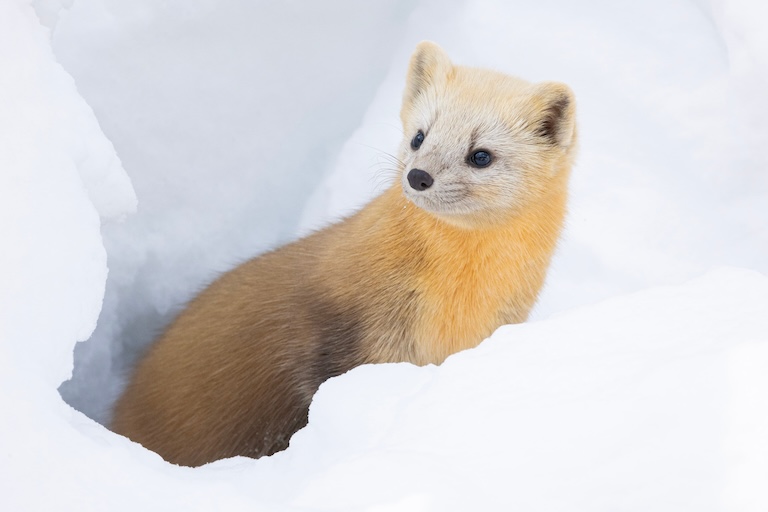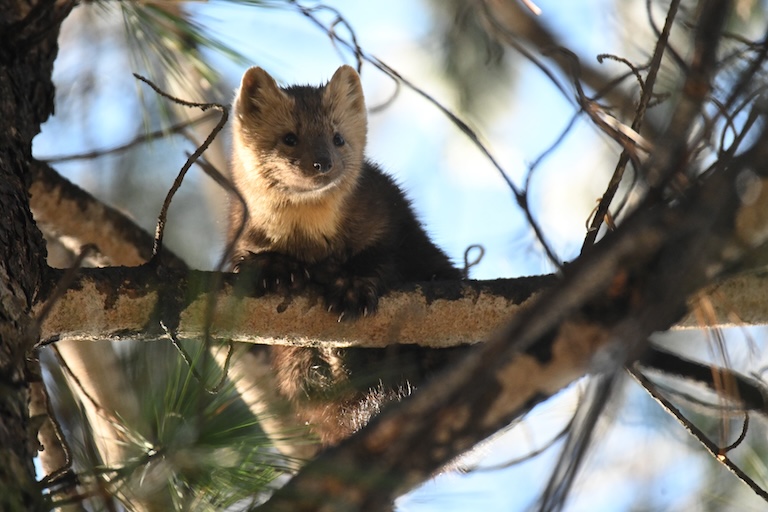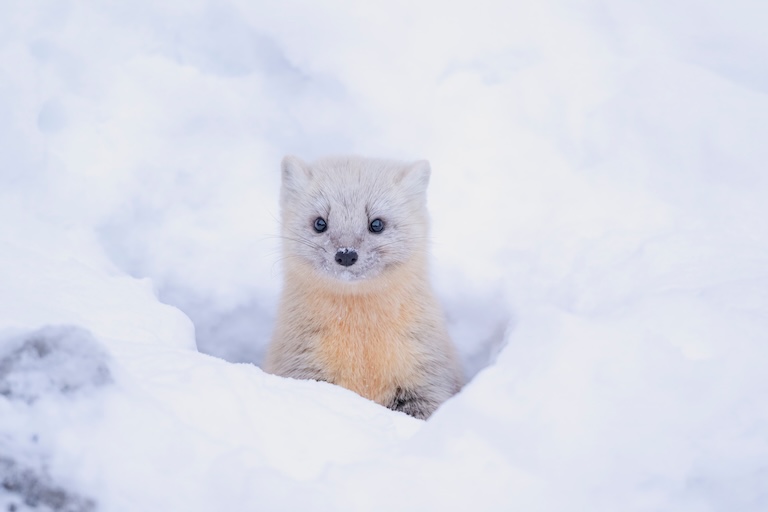Sable Profile
In the order Carnivora, we find the most formidable predators on land. Polar bears, Lions, leopard seals (they’re on land sometimes), all the big cats, all the small cats, all the dogs, hyenas and bears and so on.
But there’s one family in this order that would, if they weren’t so humble, take exception to all this misplaced attention. This would be the family Mustelidae. A diverse and world-conquering family of small predators who, for their size, are the most badass creatures on Earth.
One such example is a tiny Marten, known as the Sable.

Sable Facts Overview
| Habitat: | Denase taiga forest, lowland and mountainous |
| Location: | Scandinavia to Northeastern China, Northern Japan |
| Lifespan: | 8 in the wild, 18 in captivity |
| Size: | Males measure 38–56 centimetres (15–22 in) in body length |
| Weight: | 1,800 grams |
| Colour: | light to dark brown |
| Diet: | Omnivorous: mice, chipmunks, hares, squirrels, eggs, birds, fish, berries, cedar nuts, and vegetation |
| Predators: | wolves, foxes, wolverines, tigers, lynxes, eagles and large owls. |
| Top Speed: | Unknown |
| No. of Species: | 1 |
| Conservation Status: | Least Concern (IUCN) |
Sables are part of the toughest family of mammals there is. But due to their size, and the fact that they sort of look like they belong to the Rodent order, their powers are underrated.
These immensely athletic and powerful animals are hard to spot, as they hunt in dense, frozen forests, but can bring down animals as much as five times their mass, and have uniquely adapted to their habitats.
One such adaptation has been the focus of fur farms for centuries, but this tenacious little fighter is of no conservation concern whatsoever, and populations are actually increasing.
Interesting Sable Facts
1. They’re mustelids!
The Mustelid family is home to a handful of iconic species like the honey badger, the savoury Eurasian badger, and the skunk. But these are relative behemoths within Mustelidae, and many more species are found hiding by rivers and inside forests.
Martens are a genus of tiny mustelids, similar to weasels and stoats, and Sables are in this genus. They can climb, they can dig, they can cover snow drifts and they can eat more or less anything, and true to the family name, they are outstanding and relentless killers.
Like all martens, sables have exceptional agility, unbeatable stamina and immense strength and despite averaging around a kilogram in weight, can bring down a 5kg hare entirely alone.
Because they spend their time in dense woodland, there aren’t so many references to these feats, but you only have to look as far as their cousins the stoats to see an animal that’s not afraid to jump on a woodpecker’s back and ride it through the air. 1
2. They’re powerful
Sables don’t always hunt. Like any truly tough animal, they’ll eat whatever they can find.
Spending time in the cold Siberian Winters, they’ll make use of wild berries and roughage when they don’t have anything to hunt, but if the opportunity presents itself, this tiny animal will take on anything from rodents and hares to marmots and musk deer.
They are excellent trackers and will follow a scent for several kilometres to find food, sometimes tracking larger predators like wolves and bears to follow them to a kill.
They’re also adept at catching fish in some locations, and will usually kill, after an exhausting chase, with a powerful bite to the neck.
Their power is worth emphasising. If you could scale down the African savanna ecosystem to where a Lion was the size of a Sable, you’d be looking at an elongated bear-like hunter that could bring down an adult African elephant, single-handed. 2

3. They can travel long distances for their size
Sables spend a lot of time foraging, and throughout their travels, cover great distances for such a little animal.
An adult can easily cover 10km per day, though they prefer to remain within about 30km radius of their homes.
This isn’t always the case, and some lone, more nomadic individuals were tracked to 300km from their tagging locations.
4. Delayed implantation
Mustelids have three styles of reproduction. Ferrets and Least Weasels are inseminated and breed in the Spring and Summer. Milk and striped skunks have variable gestation periods and can hold off implantation for a little while after insemination if the time isn’t right.
But most Mustelids, including the Sable, have a prolonged period of what’s called embryonic diapause, or “delayed implantation” – the time between bumpin’ uglies and getting officially pregnant.
When interfering researchers tried to screw with the hormones of the animals to affect this delay, they couldn’t, so nobody quite knows how it works, but it’s a great adaptation that takes advantage of resources while they’re available; allowing the female to get laid when the options are good and then pick a better time to give birth.
From fertilisation of the egg, around eight months pass before it’s implanted and begins to grow. After this point, it’s all systems go, and development takes only a month. 3
5. They’re cold-weather animals
This is likely a response to the harsh Winter conditions of their Far Northern environment. Sables have a whole bunch of tricks up their sleeve to survive Siberian Winters, including the ability to fast for long periods.
Like many cold-weather animals, they fatten up when times are good and survive off the surplus through the peak of the cold.
Another excellent adaptation is the moult. This is when the coat they grew in the Spring falls out in response to the approach of Winter light cycles, giving way to a thick, insulating coat sometime around late August to November. 4
6. They’re farmed for their fur
This coat was recognised by old Slavic hunters as a brilliant substitute for a tracksuit and much of what we know today about this animal comes from historical hunting records.
This is a species that does well in captivity, at least, up until the time they’re killed and skinned, but they’re also common in city zoos where doing this sort of thing to the exhibits is frowned upon.
There were an estimated 2 million of these ruthless carnivores in the wild by 2011, and their numbers are likely higher today. This is despite an annual production of between 300,000 and 400,000 pelts coming in from the wild. 5
7. They’re on the rise
In the 2010s, Sable populations were looking good, and the Russian population of 2 million was complemented by several thousand in China and around 10,000 in Mongolia. There were no estimates for the remaining countries in their range, but those numbers would likely have been lower.
Still, Sable numbers are thought to be continuously rising, which is great news for everybody, especially the family Mustelidae, who have yet another champion. 6

Sable Fact-File Summary
Scientific Classification
| Kingdom: | Animalia |
| Phylum: | Chordata |
| Class: | Mammalia |
| Order: | Carnivora |
| Family: | Mustelidae |
| Genus: | Martes |
| Species: | Zibellina |
Fact Sources & References
- BBC News (2015), “Extraordinary: Weasel rides on woodpecker’s back – BBC News”, Youtube.
- Vladimir G (2011), “Martes zibellina (Carnivora: Mustelidae)”, Sci Hub.
- R A Mead (1981), “Delayed implantation in mustelids, with special emphasis on the spotted skunk”, NIH.
- Anne-Mari Mustonen (2006), “Adaptations to fasting in a terrestrial mustelid, the sable (Martes zibellina)”, Science Direct.
- Vladimir G. Monakhov (2011), “Martes zibellina (Carnivora: Mustelidae)”, Oxford Academic.
- “Sable”, IUCN Red List.
